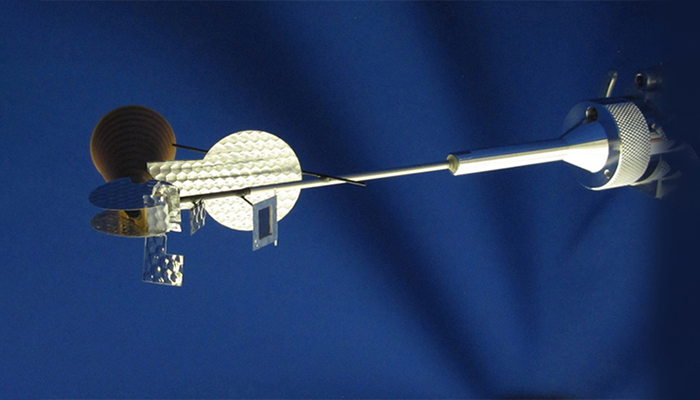Probing the Temperature of Materials
Under Extreme Pressure at NIF
December 12, 2023
 A copper target for an extended x-ray absorption fine structure (EXAFS) experiment is mounted on the target positioner prior to insertion into the NIF Target Chamber. Credit: Luis Zeledon
A copper target for an extended x-ray absorption fine structure (EXAFS) experiment is mounted on the target positioner prior to insertion into the NIF Target Chamber. Credit: Luis Zeledon In new LLNL experiments at NIF, scientists measured the extended x-ray absorption fine structure (EXAFS) of copper to probe its temperature under extreme pressure. The research was published in the journal Nature Communications.
Dynamic compression experiments at high energy density laser facilities have expanded the frontier for studying material responses under extreme pressures, making a possible comparison with theoretical predictions under a wide range of conditions, including those relevant for planetary science and inertial confinement fusion (ICF).
The temperature of the compressed materials, however, has been largely unknown or derived from models and simulations, due to the lack of diagnostics under those challenging conditions.
EXAFS refers to modulations in the x-ray absorption spectrum caused by photoelectron waves scattering off nearby atoms, which are sensitive to the local structure and thermal disorder (temperature) in the material’s lattice structure. The team measured the modulations by probing a compressed copper sample using a bright, broadband x-ray source under pressures up to 1 terapascal, which is approximately 9.8 million atmospheres of pressure, or about three times the pressure at the center of the Earth.
“In these experiments, the copper temperature is in reasonable agreement with simulations when adjacent to lithium fluoride, a transparent window material commonly used in dynamic-compression targets,” said LLNL physicist Hong Sio, the paper’s lead author. “However, the temperature becomes unexpectedly much higher than predicted when adjacent to diamond, demonstrating the important influence of the sample environment on the thermal state of materials.”
Sio said the results nearly double the highest pressure at which EXAFS has been reported in any material, and demonstrate that temperature, density, pressure, and local structure can be experimentally constrained in a single experiment at pressures of hundreds of gigapascals. While there are other techniques for measuring the surface temperature of a material, EXAFS provides the bulk temperature throughout the material and has higher sensitivity at lower temperature.
 The final copper EXAFS target assembly. In the experiment, NIF lasers are used to compress the copper sample to high pressure and to drive a backlighter to generate a bright x-ray flash that probes the copper sample during peak compression. Credit: NIF Target Fabrication
The final copper EXAFS target assembly. In the experiment, NIF lasers are used to compress the copper sample to high pressure and to drive a backlighter to generate a bright x-ray flash that probes the copper sample during peak compression. Credit: NIF Target Fabrication On NIF, the goal of the EXAFS platform is to provide reliable temperature measurement in equation-of-state experiments of materials relevant for weapon physics. The equation of state of a material can be thought of as a model relating the three thermodynamic variables: pressure, density, and temperature.
NIF researchers routinely perform experiments on specific materials at pressures of hundreds of gigapascals or a terapascal in regimes of interest for stockpile stewardship, planetary science, and ICF. There are mature platforms using velocimetry to constrain pressure and x-ray diffraction to constrain density/phase. The missing piece is an experimental constraint on temperature; EXAFS is designed to fill this gap in the Lab’s diagnostic capabilities.
Copper was specifically chosen for this study because there is no expected phase transition along the dynamic ramp-compression path that may complicate data interpretation. With large EXAFS amplitudes, copper is uniquely suited for developing the NIF EXAFS platform, iterating on the target design, and benchmarking analysis techniques.
“What we learned about in these copper EXAFS experiments,” Sio said, “prepared us for the more difficult ongoing EXAFS measurements in higher-Z materials (tantalum, lead, and ultimately plutonium) and also provided new physics insights on how temperature may differ from hydrodynamic simulations in dynamic compression experiments on NIF.”
The team also plans follow-up experiments to investigate the abnormal heating from adjacent diamond layers.
“The EXAFS results in this work are specific to copper,” Sio said, “but the platform and methodology are expected to be generally applicable to many mid-Z elements (such as iron in Earth core conditions) to define the phase boundaries that are important in understanding the evolution of planet cores. This is a new diagnostic capability on NIF for studies of materials in high-energy-density conditions.”
Other LLNL team members include Yuan Ping, Andy Krygier, Dave Braun, Rob Rudd, Stanimir Bonev, Federica Coppari, Marius Millot, Dayne Fratanduono, Neal Bhandarkar, Montu Sharma, Jacob Riddles, Amy Coleman, Dave Bradley, Jon Eggert, Randolph Hood, Warren Hsing, Nobuhiko Izumi, G. Elijah Kemp, Bernard Kozioziemski, Nino Landen, Korbie Le Galloudec, Camelia Stan, Tom Lockard, Andrew MacKinnon, James McNaney, Neil Ose, Jacob Corbin, Hye-Sook Park, Bruce Remington, Marilyn Schneider, Stanislav Stoupin, Daniel Thorn, and Christine Wu.
Researchers Scott Vonhof of General Atomics and Manfred Bitter, Philip Efthimion, Lan Gao, and Kenneth Hill from Princeton Plasma Physics Laboratory also contributed to this project.
More Information:
“Researchers Develop X-Ray Source to Measure Extreme Temperatures at NIF,” NIF & Photon Science News, January 22, 2021
—Anne Stark
Follow us on Twitter: @lasers_llnl



